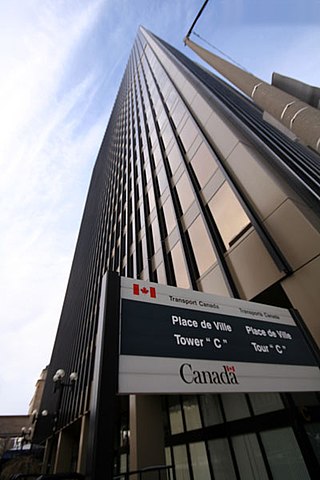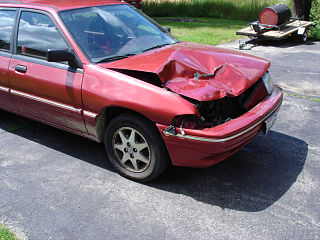Related Research Articles
Different methods of transportation in South Africa include roads, railways, airports, and water. Most people in South Africa use informal minibus taxis as their primary mode of transport. BRT, a bus service, has been implemented in some South African cities to provide more formalised and safer public transport services. These systems have been criticised due to their significant capital and operating costs. South Africa has many major ports, including Cape Town, Durban, and Port Elizabeth.

Since the start of the twentieth century, the role of cars has become highly important, though controversial. They are used throughout the world and have become the most popular mode of transport in many of the more developed countries. In developing countries cars are fewer and the effects of the car on society are less visible, however they are nonetheless significant. The development of the car built upon the transport sector first started by railways and bicycles. They introduced sweeping changes in employment patterns, social interactions, infrastructure and the distribution of goods.

Road traffic safety refers to the methods and measures used to prevent road users from being killed or seriously injured. Typical road users include pedestrians, cyclists, motorists, vehicle passengers, and passengers of on-road public transport.

Safety in numbers is the hypothesis that, by being part of a large physical group or mass, an individual is less likely to be the victim of a mishap, accident, attack, or other bad event. Some related theories also argue that mass behaviour can reduce accident risks, such as in traffic safety – in this case, the safety effect creates an actual reduction of danger, rather than just a redistribution over a larger group.

Transport Canada is the department within the Government of Canada responsible for developing regulations, policies and services of road, rail, marine and air transportation in Canada. It is part of the Transportation, Infrastructure and Communities (TIC) portfolio. The current Minister of Transport is Pablo Rodriguez. Transport Canada is headquartered in Ottawa, Ontario.

Motorcycle safety is the study of the risks and dangers of motorcycling, and the approaches to mitigate that risk, focusing on motorcycle design, road design and traffic rules, rider training, and the cultural attitudes of motorcyclists and other road users.

Bicycle safety is the use of road traffic safety practices to reduce risk associated with cycling. Risk can be defined as the number of incidents occurring for a given amount of cycling. Some of this subject matter is hotly debated: for example, which types of cycling environment or cycling infrastructure is safest for cyclists. The merits of obeying the traffic laws and using bicycle lighting at night are less controversial. Wearing a bicycle helmet may reduce the chance of head injury in the event of a crash.

Transportation safety in the United States encompasses safety of transportation in the United States, including automobile crashes, airplane crashes, rail crashes, and other mass transit incidents, although the most fatalities are generated by road incidents annually killing 32,479 people in 2011 to over 42,000 people in 2022. The number of deaths per passenger-mile on commercial airlines in the United States between 2000 and 2010 was about 0.2 deaths per 10 billion passenger-miles. For driving, the rate was 150 per 10 billion vehicle-miles: 750 times higher per mile than for flying in a commercial airplane.

A cycle track or cycleway (British) or bikeway, sometimes historically referred to as a sidepath, is a separate route for cycles and not motor vehicles. In some cases cycle tracks are also used by other users such as pedestrians and horse riders. A cycle track can be next to a normal road, and can either be a shared route with pedestrians or be made distinct from both the pavement and general roadway by vertical barriers or elevation differences.
The units of measurement in transportation describes the unit of measurement used to express various transportation quantities, as used in statistics, planning, and their related applications.

A tram accident is any accident involving a tram or tram system.

86 percent of people in the United States use private automobiles as their primary form of transportation to their workplace.

The use of horses for transportation, either by horseback riding or by driving carriages and wagons on roads, was the primary form of transportation before the advent of automobiles in the late 19th century. However, horses are still used for transport in many parts of the world, including places where certain sects such as the Amish reside. Horses are also ridden on the roads for pleasure, for example travelling from their stables to bridle paths and trails. Equestrians and motorists should take safety precautions to avoid serious accidents when sharing the roadways.

Road traffic collisions generally fall into one of five common types:

A traffic collision, also known as a motor vehicle collision, or car crash, occurs when a vehicle collides with another vehicle, pedestrian, animal, road debris, or other moving or stationary obstruction, such as a tree, pole or building. Traffic collisions often result in injury, disability, death, and property damage as well as financial costs to both society and the individuals involved. Road transport is statistically the most dangerous situation people deal with on a daily basis, but casualty figures from such incidents attract less media attention than other, less frequent types of tragedy. The commonly used term car accident is increasingly falling out of favor with many government departments and organizations, with the Associated Press style guide recommending caution before using the term. Some collisions are intentional vehicle-ramming attacks, staged crashes, vehicular homicide or vehicular suicide.

Worldwide, it was estimated that 1.25 million people were killed and many millions more were injured in motor vehicle collisions in 2013. This makes motor vehicle collisions the leading cause of death among young adults of 15–29 years of age and the ninth most frequent cause of death for all ages worldwide. In the United States, 40,100 people died and 2.8 million were injured in crashes in 2017, and around 2,000 children under 16 years old die every year.

Cycling infrastructure is all infrastructure cyclists are allowed to use. Bikeways include bike paths, bike lanes, cycle tracks, rail trails and, where permitted, sidewalks. Roads used by motorists are also cycling infrastructure, except where cyclists are barred such as many freeways/motorways. It includes amenities such as bike racks for parking, shelters, service centers and specialized traffic signs and signals. The more cycling infrastructure, the more people get about by bicycle.

People who are driving as part of their work duties are an important road user category. First, workers themselves are at risk of road traffic injury. Contributing factors include fatigue and long work hours, delivery pressures, distractions from mobile phones and other devices, lack of training to operate the assigned vehicle, vehicle defects, use of prescription and non-prescription medications, medical conditions, and poor journey planning. Death, disability, or injury of a family wage earner due to road traffic injury, in addition to causing emotional pain and suffering, creates economic hardship for the injured worker and family members that may persist well beyond the event itself.

There is debate over the safety implications of cycling infrastructure. Recent studies generally affirm that segregated cycle tracks have a better safety record between intersections than cycling on major roads in traffic. Furthermore, cycling infrastructure tends to lead to more people cycling. A higher modal share of people cycling is correlated with lower incidences of cyclist fatalities, leading to a "safety in numbers" effect though some contributors caution against this hypothesis. On the contrary, older studies tended to come to negative conclusions about mid-block cycle track safety.
List of cyclist or cycling deaths in U.S. by year
References
- ↑ "Archive:Transport accident statistics". ec.europa.eu. Retrieved 2024-05-03.
- ↑ Jennifer Oxley; Bruce Corben; Brian Fildes; Mary O’Hare; Talib Rothengatter (December 12, 2010). "Older Vulnerable Road Users – Measures to Reduce Crash and Injury Risk". Monash University Researcn Accident Centre.
- ↑ The risks of travel Archived September 7, 2001, at the Wayback Machine . The site cites the source as an October 2000 article by Roger Ford in the magazine Modern Railways and based on a DETR survey.
- ↑ Beck, L. F.; Dellinger, A. M.; O'neil, M. E. (2007). "Motor vehicle crash injury rates by mode of travel, United States: using exposure-based methods to quantify differences". American Journal of Epidemiology. 166 (2): 212–218. doi: 10.1093/aje/kwm064 . PMID 17449891.